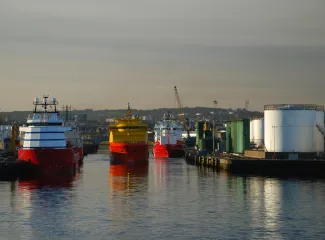
A crucial factor in the energy transition drive to meet net-zero targets is ensuring the right infrastructure is in place to support major renewable projects.
Offshore wind developments in particular need an Operations & Maintenance (O&M) facility at which to base their vessels and staff.
Many more of these O&M bases need to be constructed over the next 10 years to adequately support the expected major expansion of offshore wind.
So far the trend has been the installation of the developer’s pontoons in an existing harbour and the development of offices and storage buildings around the existing quayside facilities.
However, there are key issues that ports and developers need to consider when agreeing contractual terms.
These include:
1. Exclusivity of use
Is the developer to be given exclusive possession of water areas? If so, can the harbour grant such rights? The harbour’s legislation may not permit such rights and bear in mind that a harbour can only grant rights which the legislation permits – any rights which contravene the legislation are “void” and therefore unenforceable (and therefore unbankable).
2. Harbour charges
Is the developer to pay as per the harbour published tariff or is to get a “special deal” (if that is permitted by the legislation) for volume? Does any special deal cover all varieties of charge e.g. goods, vessel, passenger, conservancy and pilotage dues? Is there an agreed mechanism for review of any special deal?
3. Dredging
Is the harbour obliged to dredge to accommodate the developer’s fleet? If so, has a dredging depth and plan been agreed? How often does the harbour require to dredge? If the harbour defaults or the developer needs “extra dredging”, can the developer carry out dredging himself? Most legislation prohibits dredging by anyone other than the harbour or its licensee, therefore the development may need a dredging licence from the harbour. As well, the developer would need to be able to use the harbour’s statutory dredging licence as well as its licence from Crown Estate to dredge parts of the harbour bed owned by Crown Estate and to deposit at the Crown Estate deposit site.
4. Developer’s works
The developer may need a “works licence” issued by the harbour under its legislation to permit the installation of pontoons, linkspans, nav lights, cranes etc.
5. Quay loadings
The developer will want to agree a level of loading which they can impose on existing quays without being liable for damage. The harbour will want the developer to accept that if that loading limit is exceeded, the developer will be liable for damage arising.
6. Water and electricity supply
Will the harbour supply water and electricity to the developer and if so what are the arrangement for charges and review of charges. And what is the liability of the harbour for failure to supply?
7. Maintenance of existing infrastructure such as quays and breakwaters
The developer will want the harbour to retain repair liability and for the developer to be able to “step in” and repair if the harbour defaults – and then deduct the costs from rent if necessary.
8. Pilotage
Is pilotage compulsory for certain classes of vessel and will this affect the developer’s fleet? Time really is money with windfarms – does the harbour have an adequately manned pilotage service so that expensive delays in vessel movements can be avoided?
9. Developer’s rights
It is best to agree early what rights the developer will have re parking, installation of fuel tanks, road access, water access and fencing and security.
While all parties wish to see strategic investment and expansion of ports and harbours infrastructure to accommodate major renewables development like offshore wind, these are just some of the items which need to be taken into consideration to futureproof such projects and avoid costly disputes and delays.
If you need specialist legal insight into this complex and fast-changing area, please get in touch to take advantage of Shepherd and Wedderburn’s market-leading expertise in Clean Energy and Real Estate projects.